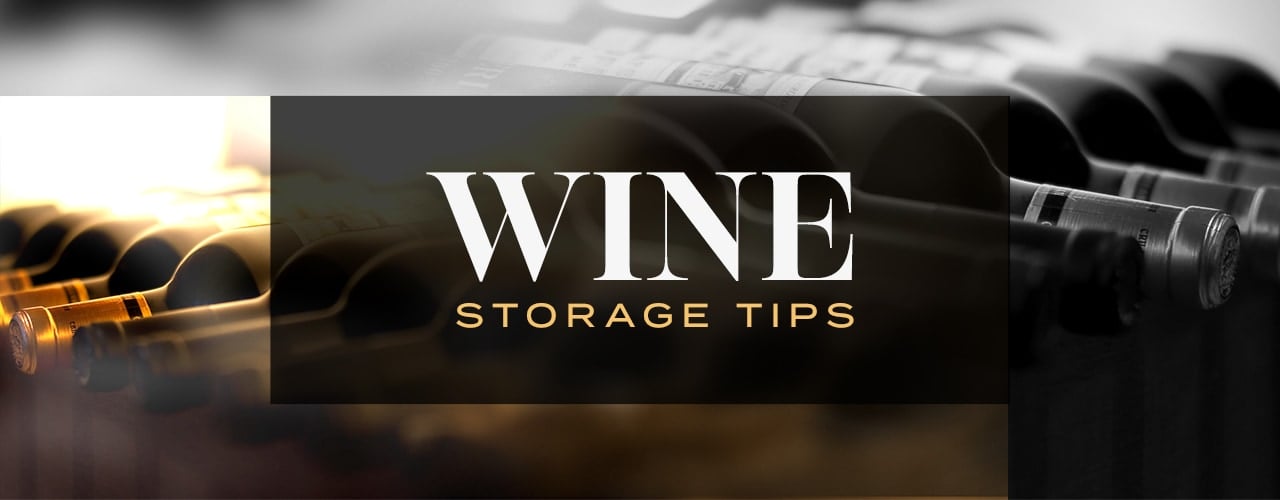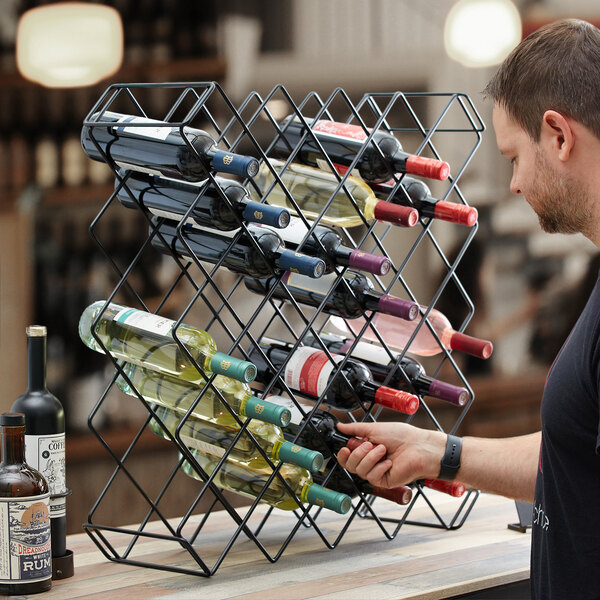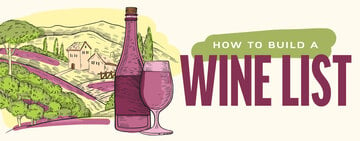
Whether you need to properly store the most popular wines for your restaurant or you're looking for long-term wine storage tips, there are a few things to always remember. Take into consideration important factors such as temperature, humidity, and air or light exposure. Additionally, it’s important to know the proper wine storage temperature for reds, whites, and everything in between. If you don’t have a designated sommelier in your restaurant, be sure to follow the tips below to get the most out of your wine reserves.
Shop All Wine Racks and ShelvesHow to Use a Wine Cooler
Learn how to store wine in a wine cooler. Wine coolers keep wine bottles at the ideal temperature. All you have to do is load them properly and place them in the ideal location, and they eliminate the guesswork of wine storage.
How to Store Wine
While wine storage isn’t complicated, there are a few ways in which you can ensure your wine tastes the way it’s supposed to when served.
1. Store Bottles Horizontally

As most people have noticed, wine bottles are typically stored horizontally in wine racks or coolers with the label facing up. While this is important to do for bottles with natural corks, storing bottles horizontally with non-natural corks such as rubber, plastic, or metal isn’t necessary but can often be a space-saving solution for smaller restaurants.
Why Is Wine Stored on Its Side?
Wine is stored on its side so liquid can stay in constant contact with the cork. This ensures the cork remains moist to prevent shrinking or cracking that would allow air to enter the bottle. Allowing air into the bottle can cause early oxidation, which will negatively impact the wine’s taste.
2. Store Wine at the Proper Temperature
If you’re storing both red and white wine in the same place, try to keep the air temperature around 55 degrees Fahrenheit. While a little above or a little below won’t do much harm, temperatures above 70 degrees Fahrenheit can age wine more rapidly than desired.
Even more extreme heat can “cook” your wine, causing the flavor and aroma to go flat. Alternatively, storing wine in areas that are too cold, such as a standard refrigerator or walk-in, can rid the wine of its natural aromas and flavors.
Temperature is paramount in conserving wine. Exposing your bottles to excessive heat, or even cold, can ruin the product. Proper wine storage temperatures can help preserve your wine for years and ensure that the wine doesn't age too quickly.
3. Keep the Temperature Steady
When storing wine bottles, you always want to make sure the ambient temperature stays consistent. Temperature consistency is as important, if not more, than the actual temperature at which you store your wine.
Drastic temperature changes can cause the liquids inside the bottle to expand and contract. This expansion and contraction can eventually push the cork out of place over time, leading to early oxidation.
4. Pay Attention to the Humidity

When it comes to the optimal level of humidity for storing wine, you’ll want to keep the humidity level between 50 and 80 percent.
Humidity levels can affect both the wine itself and the label. If you're serious about maintaining pristine bottles—including the labels—you'll want to pay close attention to humidity. Storing your wine in a relatively humid environment is another way to ensure the cork stays moist enough to keep air out.
On the other hand, keeping the ambient air too humid can damage the label on your wine bottles over time. Too much humidity can cause mold to form on the labels, ruining the outside of your bottle. While this won’t affect the wine within, and can ruin your chances of using that bottle in your restaurant.
5. Limit Light Exposure
Light in general, and especially UV rays, can prematurely age your wine similarly to air exposure and heat. Most bottles utilize tinted glass to help prevent this. But if you’re looking to keep your bottles in storage for a while, store them in a dark area away from direct sunlight and harsh fluorescent lighting.
6. Avoid Movement and Vibrations
Vibrations from heavy kitchen equipment and cooling appliances can harm your wine when it’s in storage. In general, you should not store bottles near such equipment, and avoid manually shaking your wine. Such movements can speed up the chemical reactions that cause wine to age more quickly.
7. Track How Long Your Wine Stays in Storage
While it’s true a fine wine can get better with age, chances are what you’re storing shouldn’t be left there indefinitely. Most new world wines or less expensive bottles should realistically be consumed within a few years of purchase. Plus, wine that stays stored too long in your restaurant isn’t helping your bottom line.
Does Wine Go Bad?
In general, red wine should be consumed within 2 to 10 years of the vintage. White wine is best when consumed within 2 to 3 years. In today’s production of fine wines, there are only a handful on the market that may actually benefit from being aged 10 years or longer.
How to Store Wine After Opening
White wine should be stored after opening in a cool, dark place like a refrigerator, wine cellar, or closet. It should be consumed within 3 to 5 days of being opened. Red wine doesn’t need to be stored in a cool area, but should be kept somewhere dark or dimly lit. While most red wines also last 3 to 5 days, some of the more acidic reds can last longer.
Here are a few tips to use when storing wine after it’s been opened:
- Recork the bottle as tight as possible to minimize exposure to air
- Transfer what’s left of the wine to a smaller bottle to reduce the amount of excess air
- Store away from light and heat
- Plug the top with a wine stopper if the original cork is unavailable
Wine Storage Temperatures
The ideal storage temperature for wine is 55 degrees Fahrenheit. However, the various types of wine can have different optimal temperatures.
These are the proper storage temperatures for white wine:
- Sparkling Wines: 40 to 45 degrees Fahrenheit
- Light-bodied or Sweet Wines: 45 to 55 degrees Fahrenheit
- Full-bodied Wines: 50 to 55 degrees Fahrenheit
And here are the proper storage temperatures for red wine:
- Light bodied: 50 to 55 degrees Fahrenheit
- Medium bodied: 55 to 60 degrees Fahrenheit
- Full bodied: 60 to 65 degrees Fahrenheit
Here’s a chart designed to help you keep track of the right wine storage temperature for each type:

Where to Store Wine
When you take into consideration all of the guidelines above, it’s no surprise that where you store your wine can have a big impact on the glass you serve your customers.
If you’re trying to figure out where to store wine, avoid the following places:
- Kitchens: They are often too hot and well-lit for wine storage.
- Highly trafficked areas: Keep bottles away from doorways or closets that are constantly being used. Storing wine here can increase your chances of temperature fluctuation and movement.
- Near windows: You never want to store wine bottles in direct sunlight.
- Around pungent smells: Don’t keep your wine bottles near strong smelling items like herbs and garlic. The wine can pick up those flavors and alter the taste.
When it comes to storing wine in your commercial kitchen, your best bet is to opt for wine shelving units or coolers.
Wine Shelving Units

These units are the most cost-effective method of storing wine in a professional setting. However, they only work well when you have a proper place to put them. Store your wine shelving units in an area that meets the above guidelines for proper temperature, humidity, and light.
Wine racks and storage cabinets are an ideal option because they save you money by working without electricity or refrigeration. They’re great if you have a wine cellar already and simply need a storage unit to hold the bottles.
Wine Coolers / Merchandisers
While regular refrigerators are often too cold to house your bottles, wine coolers are designed to store your wine at precise temperatures. Some even have multiple zones to allow for storage of different kinds of wine within the same cabinet.
Some coolers are designed to merchandise wine as well. Merchandisers are made to show off the product to customers at your wine shop while keeping it at the ideal temperature.
Heavy Duty Wine Refrigerators
Wine refrigerators are ideal for use at upscale restaurants that serve high volumes of wine. These large refrigerators can often hold up to 200 bottles of wine at the right temperature for serving.
Evaluate your restaurant’s space to determine the best area to house your selection of wine. By paying close attention to the temperature, humidity level, and light exposure, you can be rewarded with quality wine guests will love. Equip your space with a simple yet effective wine rack, or kick your beverage service up a notch with a heavy duty wine fridge.





